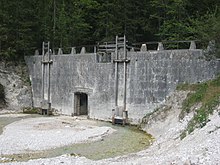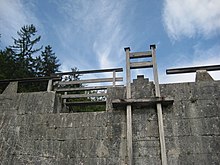Chorinsky hermitage
The Chorinsky-Klause in Weißenbachtal near Bad Goisern on Lake Hallstatt is a dam built at the beginning of the 19th century with which the water of the Weißenbach can be used for wood drift . Up to 75,000 m³ of water can be drained off within a few minutes. The Chorinsky Klause is a prototype of the forestry tradition in the Upper Austrian Salzkammergut . At the beginning of the 21st century, the system is still fully functional and is a technical monument under monument protection .
Economic starting point
Wood as an energy source
The provision of wood as fuel for the alpine salt pans was the critical factor in the energy-intensive salt production up until the second half of the 19th century. Only with the introduction of coal firing in the brewhouses from 1870 and the associated drastic decline in demand for firewood did it lose Trift creatures in importance. In the Hallstatt Pfannhaus alone, around 230 m³ of wood was being burned every day by the end of the 16th century. This enormous wood requirement of the salt pans triggered a rationalization of the forestry as well as the transport system early on.
Timber transport
The Trift proved to be a suitable and economically justifiable transport system for bringing wood into the water-rich mountain regions. However, in very few mountain streams it was possible to wash the wood at normal water levels, known as self-water. Occasional water like the snowmelt or that of heavy rain were no longer sufficient to drift the required amounts of wood at the beginning of modern times.
Therefore, water was often dammed by dams, the Klausen spanned and quickly drained at the desired time. The wood piled up below the Klausen was washed down the valley in this way. Due to the drifting in the steeply falling streams, the quality of the wood suffered, as it was pounded at the ends by the force of the impact on the rocky banks, but this fact was insignificant for the combustion. Since the 1890s, the valleys of the Salzkammergut have been developed according to plan through forest paths and roads, on which the wood was first driven by sledges and wagons and later by trucks.
Trift building
At the end of the 19th century there were still 39 Klausen, 16 water catchments , 48 main gravel works, 24 water giants and 22 wooden rakes in the Trift buildings in the Austrian Salzkammergut .
Building history
The first verifiable wooden predecessor of the Chorinsky-Klause is documented for 1526, a new building followed in 1535/36, and as early as 1563 a "New Klausen Bau" was arranged in the second Reformation dragonfly in Weißenbach. New buildings in this hermitage are documented for the years 1656 and 1766. In the decade between 1809 and 1819, the hermitage, which still exists today, was finally built under the direction of the Ischler Waldmeister Pfifferling. The dam was given its name by Ignaz Karl Graf Chorinsky , then Vice-President of the Lower Austrian Court Chamber , in whose presence the hermitage was put into operation; Extensive restoration work took place from 1968 to 1971.
Building description
The dam, which is curved against the pressure of the water, is broken through by a centrally positioned claw gate and the two lower gravel gates. In the middle of the crest of the wall, a channel with a rectangular cross-section is cut, which allows the water masses above the dam target to drain away. In the upper area of the Klausen enclosure, access to the Klaustor is via a footbridge or through an arched corridor. Next to the Chorinsky-Klause is an example of the traditional, true-to-size stone construction, the Klausstube, which is covered with a half-hipped roof, the house of the Klausen keeper, which was built at the same time as the Klause and now serves as a hunting lodge.
hermitage
The 28.27 m long structure is founded on an adjacent rock bank. The Klaus body itself consists of two limestone cuboid walls, with the water wall being vertical and straight. The air-side wall falls out of alignment towards the top and has a floor plan that is arched towards the Klaushof. The space between the rectangular walls except for a Tegel layer behind the water wall with a settlement of rubble filled and sediment. The crest of the 6.21 m high dam is paved with limestone slabs, the wooden railings, each bordered by stone obelisks, rest on stone pillars in the form of truncated pyramids. With the Chorinsky Klause, a maximum backflow of 75,000 m³ of water can be achieved.
Claustors
When the water is drained, the locking of the single-winged wooden claw gate, which can be rotated on a pin, is opened by means of a hammer and then pushed outwards by the water, which flows out at a rate of 13 m³ per second.
Monument value
The Klausen building, which has been preserved in its original form and function, is an important testimony to the Aryan economic culture of the region due to the excellent stone work that is designed to be durable . In the interplay between technical structure and originally preserved natural space, the hermitage represents the inner Salzkammergut.
Tourist use
The opening of the hermitage, the so-called beating, already attracted numerous onlookers in the 19th century. The hermitage was still struck several times as a tourist attraction during the summer months, even when no more wood was drifted. Today Chorinsky-Klause can no longer be beaten because of environmental protection.
Comparative examples
- Klausen-Leopoldsdorf , Hauptklause
- Pichl-Kainisch near Bad Aussee , Riedbachklause
- Weichselboden , Prescenyklause
swell
- F. Hafner: Construction and use of Trift clauses in Austria from the 13th century to the abandonment of the Trift in the 20th century, in: Blätter für Technikgeschichte, 39./40. Heft, Vienna 1980, p. 54.
- E. Koller: The wood drift in the Salzkammergut . Linz 1954, p. 29 f.
- E. Schollmayer: Die Staatsforste des Salzkammergut, in: Österreichische Vierteljahresschrift für Forstwesen, Vol. New XX, Vienna 1902, p. 252.
- H. Schönwiese: The development of forestry in Upper Austria-Styria. Salzkammergut since the middle of the 19th century, in: Öst. Quarterly journal for forestry, III. Heft, Vienna 1927, p. 104.
- C. Schraml: The Upper Austrian saltworks from the beginning of the 16th to the middle of the 18th century . Vienna 1932, p. 396 f.
- Ders .: The Upper Austrian saltworks from 1818 until the end of the Salt Office in 1850 . Vienna 1936, p. 374.
- L. Hauska: Major timber extraction equipment from the 12th to the 19th century in Austria, in: Sheets for the History of Technology, first issue, Vienna 1932, p 140.
Holztrift (pdf)
audio reportage Wood Drift (mp3)
Web links
Individual evidence
Coordinates: 47 ° 39 '7 " N , 13 ° 33' 3.9" E

